You have already visited Seville on more than one occasion and want to see new things.
Seville is a huge city with lots of charming places to discover. In this post we are going to recommend 10 charming places or activities in the capital of Andalusia. Read on to discover authentic Seville.
We’ve been to each of the places described in the post, so we recommend them on a personal basis. But if you are looking for the 10 best rated places in Seville follow the link. And if you need a private tour of Seville, here are the best.
What you will find here
Plaza del Cabildo
This is a semicircular square unknown to tourists and even to some Sevillians, but with a special charm. It is arranged around a central fountain with lush vegetation. On the other side of the semicircle, the Almohad wall encloses the square. Particularly beautiful are the accesses through passages. The lower levels of the square have an interesting solution of arches on columns that follow the curved development of the façade. The overhangs are also decorated with frescoed floral motifs.
On Sundays there is a flea market where you can find numismatics, minerals, antiques and philately. It is a good time to visit, as you can feel the local atmosphere from early in the morning. The gates are closed at night, so it is not possible to visit it.
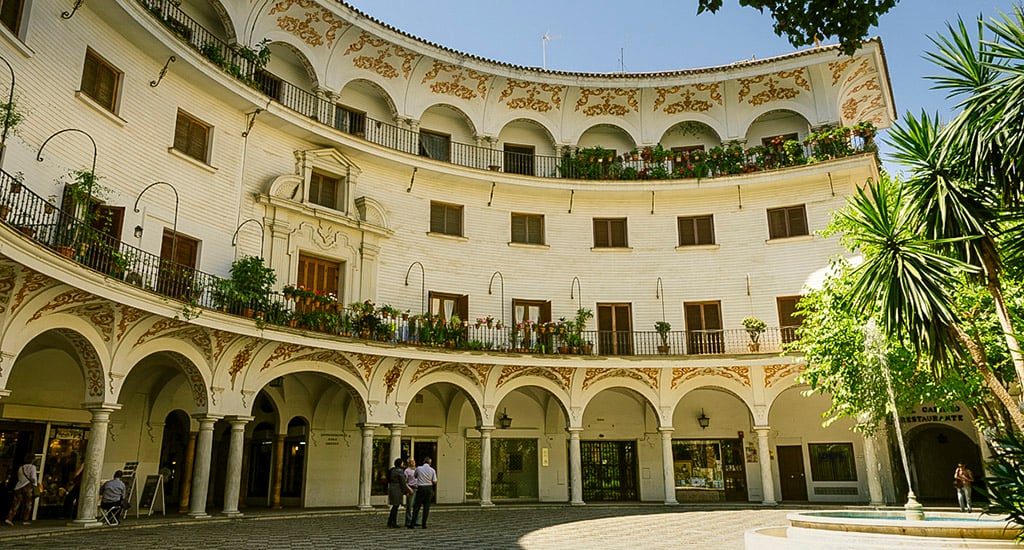
The Plaza del Cabido is a place to walk around (Sandra Vallaure. Flickr. CC BY 2.0).
Paddle under the Triana bridge
The Guadalquivir river as it passes through Seville was diverted years ago to prevent flooding in the city. The old riverbed is now a dock without currents. Using a paddle surf board to paddle along it is an alternative activity to the crowded tourist boats. The paddling is very comfortable in the calm waters of the dock and the good temperature of Seville allows the activity to be carried out even at night. The night trips take place at dusk to see how the light in the sky changes and the city lights up. From the river you will see the city from a very different perspective. In Paddle Surf Sevilla they make it easy for you.
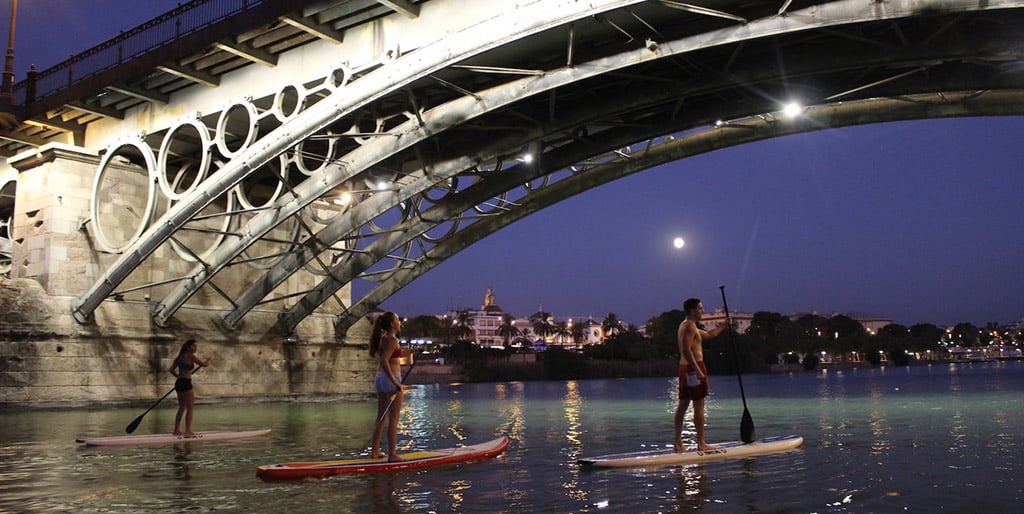
Paddling with a full moon under the Triana Bridge, enjoying in Seville is easy.
Plaza de América
Everyone knows the Plaza de España, and no wonder, but if you go to Parque de María Luisa and you have time you must visit the Plaza de América. It is somewhat smaller than the first but particularly charming for its geometry, buildings and vegetation.
It is an elongated square flanked by imposing buildings that are well worth a visit. The Archaeological Museum of Seville, the Museum of Popular Arts and Customs and the Royal Pavilion, all of them historicist buildings. In 1914 this space was already functioning as a park. In the years to come, the adjoining buildings were constructed for the Ibero-American Exhibition of 1929.
Away from the hustle and bustle of Plaza España, water and vegetation play a special role in the gardens of Plaza de América. We recommend a visit to the Cervantes roundabout in front of the Royal Pavilion. It is an octagonal space with benches lined with cuerda seca tiles. They tell the story of Don Quixote de la Mancha and pay homage to its author, Miguel de Cervantes Saavedra.

Aerial view of the Plaza América and the 3 big buildings that surround it.
El Rinconcillo
As they themselves indicate in their web, it is “A corner with centuries of history“. And so it is, the establishment was founded as a tavern in 1670, almost nothing. In fact, it is considered to be the oldest bar in Seville. As you walk down Calle Gerona, you’ll be struck by its wooden façade and colourful groin tiles. As you enter, you will get the feeling of being in an original place, a place with a long tradition. Your gaze will travel from one place to another through the wooden showcases full of wines, between the Mudejar and modern Sevillian skirting boards. Not a single detail has been lost, from the hooks for hanging the sausages to the medicine cabinet, and the beautiful ceramic and stone floors. Gastronomic tradition is combined with an air of modernity in the presentation of its tapas.
A classic of this bar is the vermouth hour. Before lunch it is customary in Seville to have a vermouth with a tapa to “make you hungry”, or at least that’s what they say. Whether you work up an appetite or not, drinking this Italian drink is a deep-rooted tradition in Andalusia that is well worth enjoying. In our land almost nobody drinks sangria on a daily basis, it is a cliché that has been wrongly exported. In fact it is an English drink that comes from the other side of the pond, from the West Indies. It is usually drunk at celebrations or on special occasions.
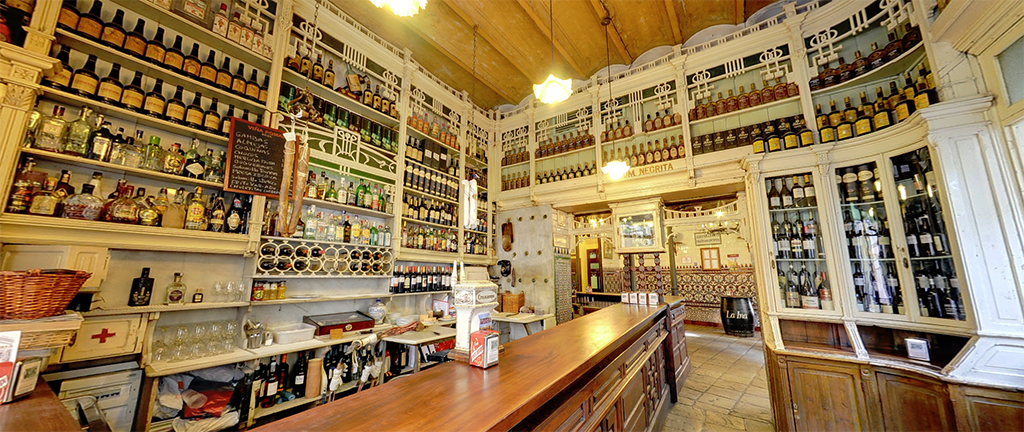
The Rinconcillo bar is without doubt a very charming place.
Atarazanas of Seville
The history of these shipyards begins after the conquest of Seville in the 13th century. Alfonso X the Wise starts the construction of the shipyards specialised in the construction of galleys. These ships played an important role in the control of the Strait of Gibraltar and the conquest of the Reign of Granada, the last Andalusian kingdom in the Iberian Peninsula. Until the 15th century, the 17 naves of this building were located in front of a sandy area next to the river bank. When it fell into disuse, other constructions occupied this sandy area and the shipyards were cut off from the Guadalquivir.
Currently only seven ships remain, in which some scenes from Game of Thrones were filmed (2nd chapter of the 7th season and several of the 8th). This spectacular building is currently closed to the public, but is due to open in 2019.

Las Atarazanas in the Arenal neighbourhood, a spectacular brick building (Sandra Vallaure. Flickr. CC BY 2.0)
Casa Morales
It is one thing to have Solera and another thing to be the Casa de Morales. This tavern is like the taverns of yesteryear. And this is not a trivial statement, it remains true to its spirit. Both in its gastronomy and its space it preserves the flavour of yesteryear. Since 1850 it has been run by the family that founded it, whose descendants we had the pleasure of meeting.
Tapas served on brown paper, Mudejar tiled baseboards, solid stone paving, a cash register that is a real gem. Everywhere you look there is some element evocative of that old tavern. But if there is one thing that impresses, it is the enormous jars for preserving wine. The owners could remove them to make more room for more tables, but they have kept them as a witness of what it was in the past.
It is very close to the Cathedral (location at the end of the post), but be careful, if you want to eat go early. The bar is always full and it’s hard to find a spot.
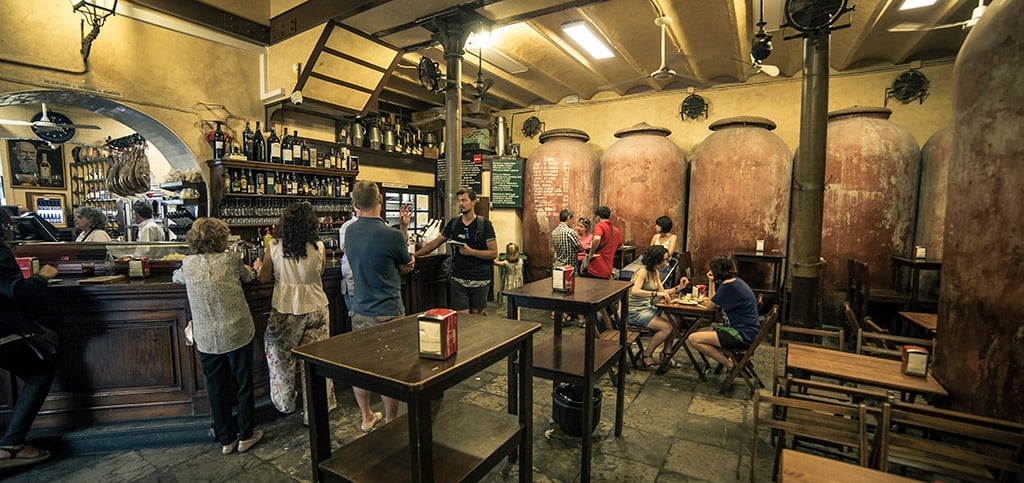
La Casa Morales is not that it’s well cared for, it’s that it’s authentic.
If YOU ARE GOING TO VISIT SEVILLE DON’T MISS THESE PRIVATE TOURS IN SEVILLE
Click on the banner to see them.
Triana Market
This market square is the typical Andalusian market. Here the people of Triana buy fresh local produce: fruit and vegetables, pulses, meat, fish, etc. In recent years, bars and cafés have been added, making it a gastronomic space.
It was built on the ruins of the castle of San Jorge, seat of the court of the Inquisition in Seville. This fortress stood until the beginning of the 19th century. The ruins of the castle can now be visited in the basement of the market. The site has been enhanced in a fairly modern way with video installations and explanatory panels.
However, this market has something that makes it unique. It is a small theatre inside. In “CasaLa Teatro” they perform flamenco, magic, humour and theatre shows. If you are going to go to the Triana neighbourhood, the market is a recommended visit.

One of those markets where tradition is maintained is the Triana Market (Visita Sevilla, official website of Seville Tourism).
Cartuja Monastery
Its official name is Monastery of Santa María de las Cuevas and it is currently the Andalusian Centre of Contemporary Art. Despite being outside the city, it is a place with a lot of history. In this area were settled some Almohad potteries from the 12th century due to the good quality of its clay. The finding of an image of the Virgin in a cave led to the beginning of worship in the area. First a hermitage was built, and in the 15th century work began on the construction of the monastery. The place was frequented by Cristopher Columbus, who came to be buried there.
In the 19th century, its religious life came to an end. First it was a barracks for the French during the invasion at the beginning of the century. Later, the merchant Carlos Pickman founded an English-style earthenware factory there. The characteristic conical towers of the site are the chimneys of the kilns for firing the pottery. In 1982 it became the property of all Andalusians, being managed by the Junta de Andalucía.
In 1992, on the occasion of the Universal Exhibition, the whole island was remodelled. It became a modern district full of unique buildings. Today there are some areas that are a little neglected due to lack of use.
It is located on the Isla de la Cartuja, which can be reached by the bridge of the same name or from the Triana neighbourhood.
- C1-C2 city bus
- Times. Tuesday to Friday 10:00-20:00 / Saturdays from 11:00-15:00 / Sundays 10:00-15:00
- Ticket prices: 1,80 €, Monument and exhibitions / 3 € complete visit
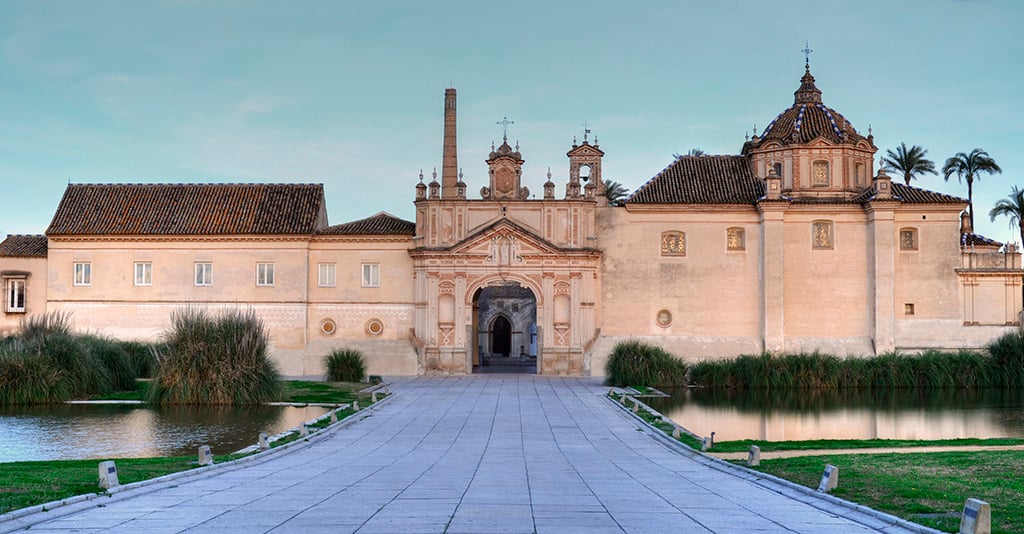
Façade of the Cartuja of Seville. In the background, the chimneys of the old pottery kilns can be seen.
Rooftop of the Hotel EME
Few places can boast these excellent views of the Cathedral of Seville. We are at the Hotel EME, a modern establishment in the heart of Seville’s capital. At the top of the hotel you will find one of those places that are so fashionable: a terrace with bar, swimming pool and good music. From here you can enjoy an unusual view of the Giralda by day and by night. You can accompany your visit with quality international cuisine and fantastic cocktails.
The terrace is open every day from 12:00 to 00:00 h.; and on Fridays, Saturdays and holidays until 01:00 h.

The fantastic views from the rooftop of the Hotel EME. When the night falls in Seville it is a perfect plan.
Alameda de Hércules
This elongated square and its surroundings have become the stage of the city’s alternative scene since the 1990s. It could be defined as the city’s bohemian area, where diversity and urban culture abound. If you want to escape from the typical Seville, this is the place for you. Its streets are full of life. You’ll find both traditional bars and new places offering innovative, vegetarian or organic cuisine.
In the centre of the square you will find two imposing Roman columns crowned by Julius Caesar and Hercules. Hercules was the hero who, according to Roman mythology, founded the city of Seville. This legendary character was also responsible for separating the mountains of the current Strait of Gibraltar (mountains that symbolise the Pillars of Hercules). At that time the ocean penetrated separating Africa and Europe and created the Mediterranean Sea.
If you are a lover of literature, be sure to pass by the door of the house where Gustavo Adolfo Béquer was born in 1836. It is located in Calle Conde de Barajas, very close to the Alameda de Hércules. On the façade there is a plaque commemorating the romantic writer who fascinated generations to come.

Seville’s sunny winter in the Alameda de Hercules (Visita Sevilla, official website of Seville Tourism).
Looking for accommodation in Seville?
Compare and find your perfect accommodation at trivago.es.
The map to locate each place
We show you the location of the places to see in Seville described in this post.

